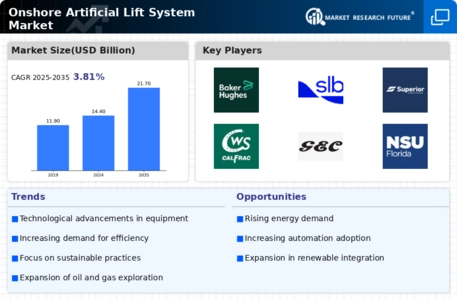Increasing Energy Demand
The Onshore Artificial Lift System Market is experiencing a surge in demand due to the increasing global energy requirements. As economies expand and populations grow, the need for efficient oil and gas extraction methods becomes paramount. This demand is particularly pronounced in regions with mature oil fields, where traditional extraction methods may no longer suffice. The International Energy Agency projects that global oil demand could reach 104 million barrels per day by 2026, necessitating advanced artificial lift technologies to optimize production. Consequently, the Onshore Artificial Lift System Market is poised for growth as operators seek to enhance recovery rates and meet energy needs.
Technological Innovations
Technological advancements play a crucial role in shaping the Onshore Artificial Lift System Market. Innovations such as electric submersible pumps, gas lift systems, and progressive cavity pumps are enhancing extraction efficiency and reducing operational costs. For instance, the integration of automation and real-time monitoring systems allows for better performance management and predictive maintenance, which can lead to a reduction in downtime. The market is projected to grow at a compound annual growth rate of approximately 5.2% from 2025 to 2030, driven by these technological improvements. As operators adopt these advanced solutions, the Onshore Artificial Lift System Market is likely to witness significant transformation.
Focus on Enhanced Oil Recovery
The Onshore Artificial Lift System Market is significantly influenced by the increasing focus on enhanced oil recovery (EOR) techniques. As conventional oil reserves deplete, operators are turning to EOR methods to maximize extraction from existing fields. Artificial lift systems, such as gas lift and water injection, are integral to these processes, enabling operators to maintain reservoir pressure and improve recovery rates. According to industry reports, EOR techniques can increase recovery rates by 10% to 30%, making them an attractive option for operators. This trend is expected to drive investments in the Onshore Artificial Lift System Market as companies seek to optimize their production capabilities.
Investment in Oil and Gas Infrastructure
Investment in oil and gas infrastructure is a key driver for the Onshore Artificial Lift System Market. As countries seek to bolster their energy security and reduce dependence on imports, there is a concerted effort to enhance domestic production capabilities. This includes the development of new drilling sites and the upgrading of existing facilities, which often necessitates the implementation of advanced artificial lift systems. According to recent estimates, investments in oil and gas infrastructure could exceed USD 1 trillion over the next decade, providing a substantial boost to the Onshore Artificial Lift System Market. This influx of capital is expected to facilitate the adoption of innovative technologies and improve overall production efficiency.
Environmental Regulations and Sustainability
The Onshore Artificial Lift System Market is increasingly shaped by stringent environmental regulations and a growing emphasis on sustainability. Governments worldwide are implementing policies aimed at reducing carbon emissions and promoting cleaner extraction methods. This regulatory landscape compels operators to adopt more efficient artificial lift technologies that minimize environmental impact. For instance, the use of electric submersible pumps is gaining traction due to their lower carbon footprint compared to traditional systems. As companies strive to comply with these regulations while maintaining profitability, the Onshore Artificial Lift System Market is likely to see a shift towards more sustainable practices and technologies.


















Leave a Comment